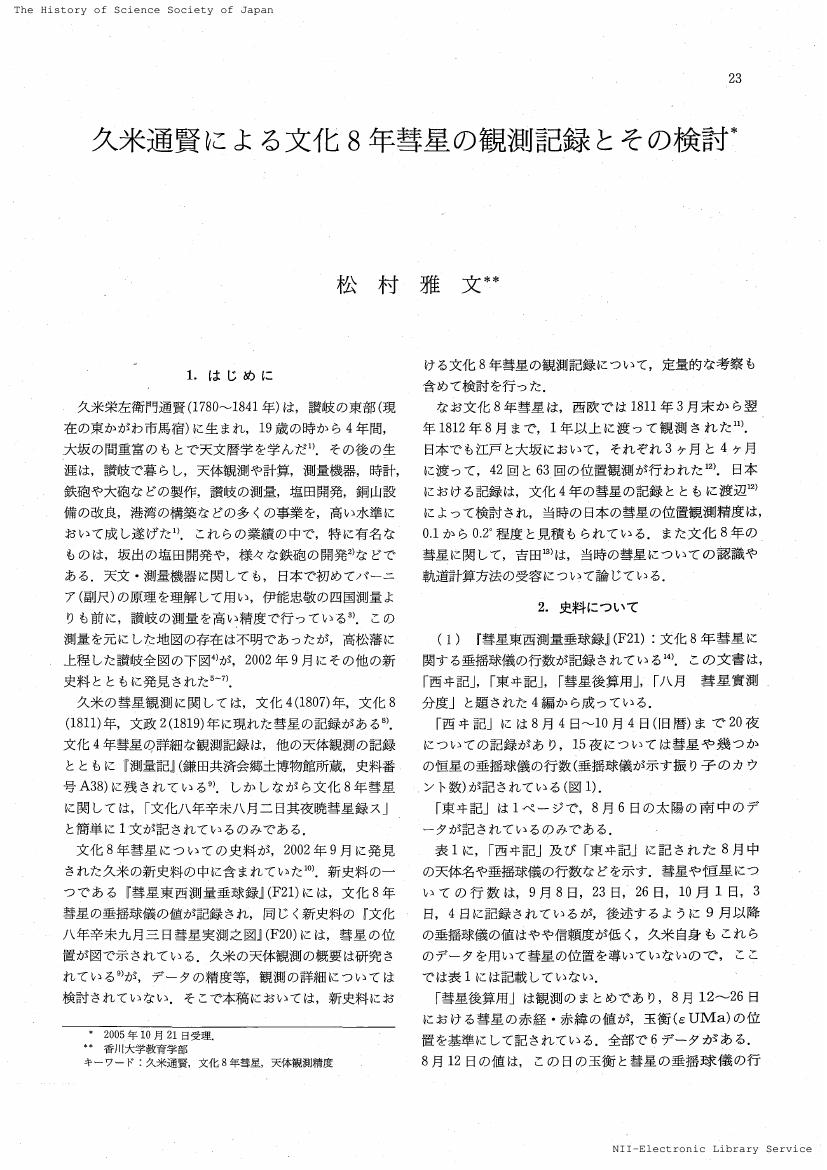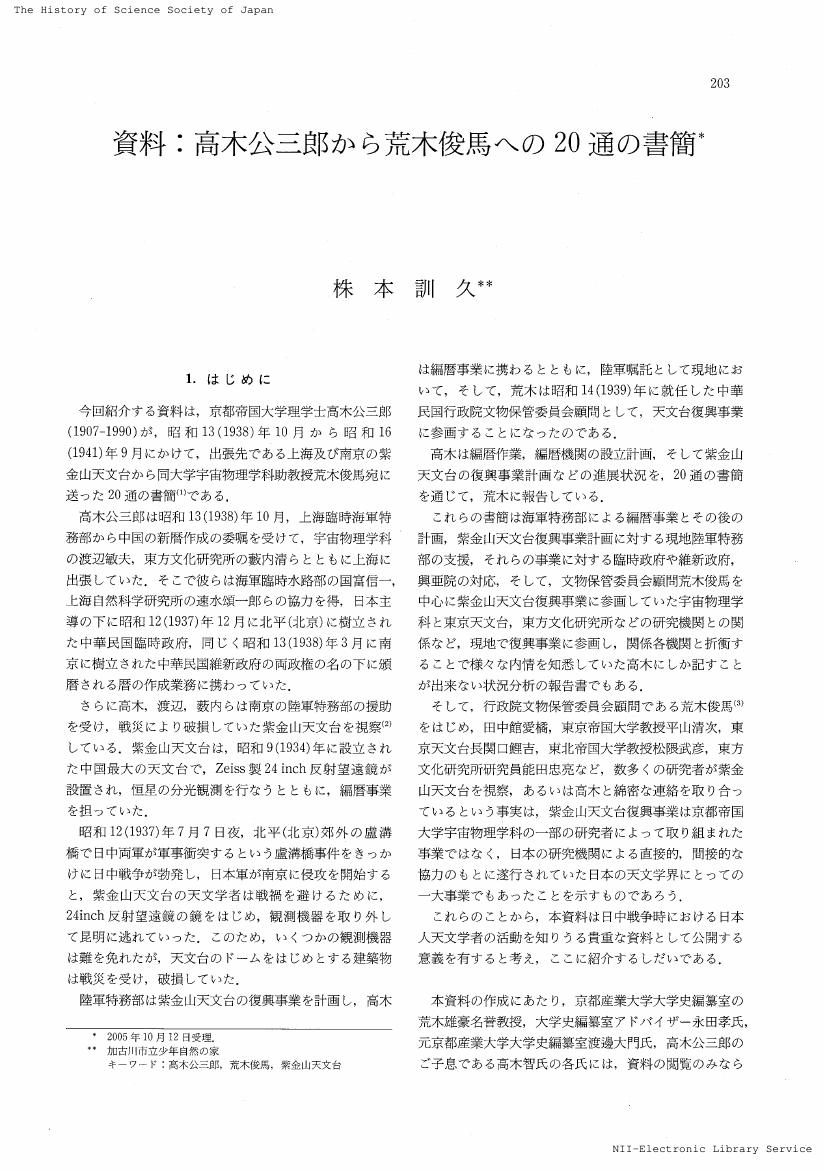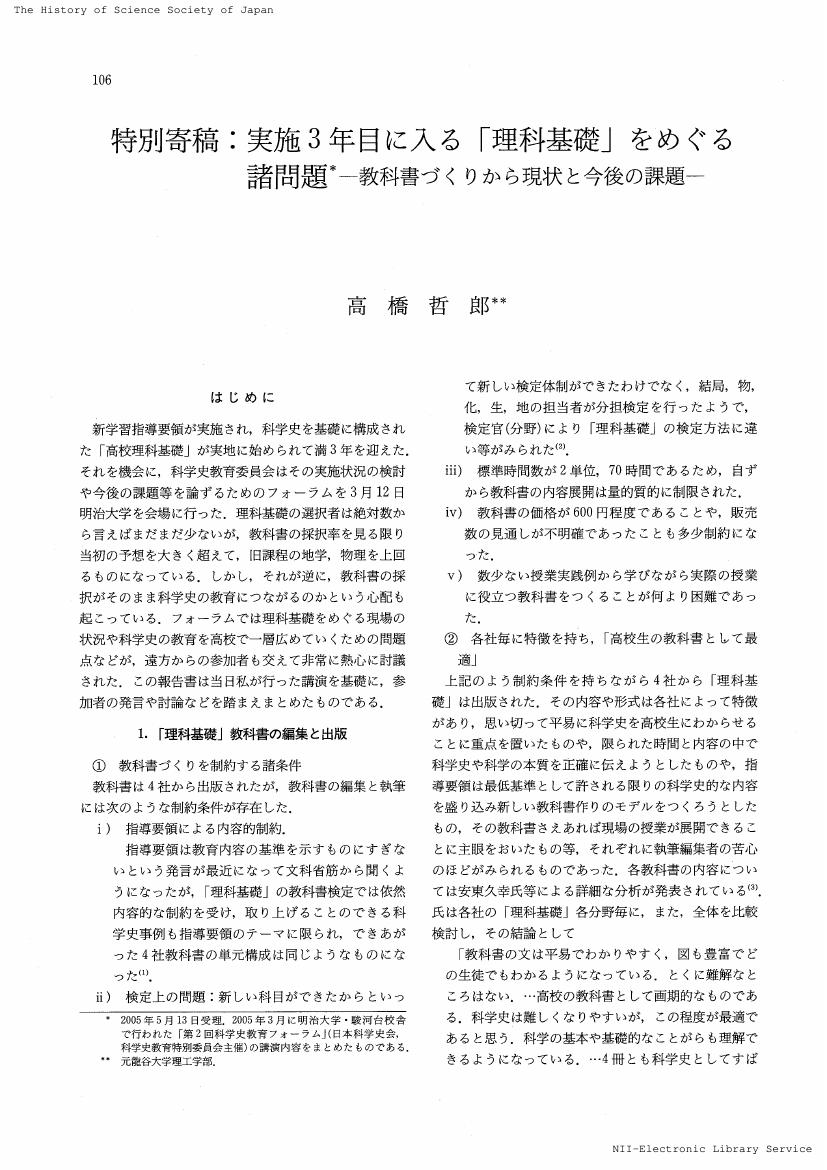1 0 0 0 OA 第22回国際科学史会議での日本からの報告
1 0 0 0 OA シンポジウム:世界から見た日本の炭鉱技術 : 炭鉱保存と技術の継承
1 0 0 0 OA 宗教と殺生観(科学史入門)
- 著者
- 中村 禎里
- 出版者
- 日本科学史学会
- 雑誌
- 科学史研究 (ISSN:21887535)
- 巻号頁・発行日
- vol.45, no.237, pp.38-41, 2006 (Released:2021-08-11)
1 0 0 0 OA 戦時中のウラン探鉱
- 著者
- 矢島 道子
- 出版者
- 日本科学史学会
- 雑誌
- 科学史研究 (ISSN:21887535)
- 巻号頁・発行日
- vol.45, no.238, pp.96-98, 2006 (Released:2021-08-11)
1 0 0 0 OA 岩橋嘉孝の『平天儀』
- 著者
- 海野 一隆
- 出版者
- 日本科学史学会
- 雑誌
- 科学史研究 (ISSN:21887535)
- 巻号頁・発行日
- vol.45, no.237, pp.29-33, 2006 (Released:2021-08-11)
1 0 0 0 OA 久米通賢による文化8年彗星の観測記録とその検討
- 著者
- 松村 雅文
- 出版者
- 日本科学史学会
- 雑誌
- 科学史研究 (ISSN:21887535)
- 巻号頁・発行日
- vol.45, no.237, pp.23-28, 2006 (Released:2021-08-11)
- 著者
- 今井 正浩
- 出版者
- 日本科学史学会
- 雑誌
- 科学史研究 (ISSN:21887535)
- 巻号頁・発行日
- vol.45, no.237, pp.11-22, 2006 (Released:2021-08-11)
The Hippocratic treatise De Natura Hominis (On the Nature of Man) has been very influential in the history of western medical thought from antiquity, because it argues the theory of four humors as the essential constituents of human body. There has been a traditional view on the theory among scholars that the author Polybos referred to Empedocles' philosophical doctrine of four elements as a model in the formation of the humoral physiology of his own. However, the theory of four humors, as compared with the doctrine of four elements, turns out to be different on the following points. 1) The four elements are introduced as substantial entities, which always remain self-identical, whereas the four humors change into one another, according to the degree of the four elemental qualities (Hot and Cold, Humid and Dry), which constitute their own nature. 2) In the Empedoclean doctrine, human nature comes into being emergently from the four elements, when they come together, or when they separate out of their primordial lump. In NH, the generation process seems to be dependent on human nature, which exists as the determinant of the conditions under which the generation can take place. 3) The Empedoclean cosmic cycle functions as a structural framework, within which the generation takes place. The cosmic system in NH has its own purpose of giving a causal explanation about how the four humors increase and decrease reciprocally in the human body, according to the alternation of the four seasons. These results will make us suppose that the philosophical influences of Empedocles on the theory of four humors remained within a very limited scope, although there are traces in some phrases and sentences as well as forms of argumentation in NH, which may be judged to be reflection of the Empedoclean philosophical poems.
1 0 0 0 OA 高木公三郎から荒木俊馬への20通の書簡
- 著者
- 株本 訓久
- 出版者
- 日本科学史学会
- 雑誌
- 科学史研究 (ISSN:21887535)
- 巻号頁・発行日
- vol.44, no.236, pp.203-224, 2005 (Released:2021-08-11)
1 0 0 0 OA サイクロトロン開発の各国比較 : 巨大科学の起源を探る(科学史入門)
- 著者
- 日野川 静枝
- 出版者
- 日本科学史学会
- 雑誌
- 科学史研究 (ISSN:21887535)
- 巻号頁・発行日
- vol.45, no.237, pp.34-37, 2006 (Released:2021-08-11)
1 0 0 0 OA 紹介
- 出版者
- 日本科学史学会
- 雑誌
- 科学史研究 (ISSN:21887535)
- 巻号頁・発行日
- vol.44, no.236, pp.232-237, 2005 (Released:2021-08-11)
1 0 0 0 OA 19世紀舶用ボイラ発達過程 : ボイラ史の研究方法によせて
- 著者
- 小林 学
- 出版者
- 日本科学史学会
- 雑誌
- 科学史研究 (ISSN:21887535)
- 巻号頁・発行日
- vol.44, no.236, pp.191-202, 2005 (Released:2021-08-11)
The historical development of steam boilers has been a popular issue among historians and engineers in Japan. The most prominent example is Seikan Ishigai. Drawing on his extensive study of the steam boiler, Ishigai defines the contradiction between power and control as an intrinsic law of the development of technology. In other words, he is a technological determinist. Trevor Pinch, Wiebe Bijker's approach (Social Construction of Technology : SCOT) and also Thomas Hughes's technological systems approach, on the other hand, give more weight to external factors, and do not give proper attention to technology's own dynamics. Critical of both the approaches, the author sees the relationship between engines and boilers as the locus of the development of the steam boiler. The author too argues that the quest for efficiency is a crucial factor in the development of marine steam engines. The author tries to show that the new engine entailed a different type of boiler, it was not opposite. That is the engine played a more crucial role than the boiler in the development of the marine propulsion system. It was the engine that moved a propeller or a paddle of a ship, not the boiler. He concludes that the history of the marine boiler is a history of relationship among the engine, the boiler and the propulsion system. An internalist or externalist approach alone may not be able to account for this complex relationship.
1 0 0 0 OA 鉄と硫黄の化合実験と共に五十年 : 実験の研究と学習の順序(科学史入門)
- 著者
- 三井 澄雄
- 出版者
- 日本科学史学会
- 雑誌
- 科学史研究 (ISSN:21887535)
- 巻号頁・発行日
- vol.44, no.235, pp.148-153, 2005 (Released:2021-08-11)
1 0 0 0 OA 紹介
- 出版者
- 日本科学史学会
- 雑誌
- 科学史研究 (ISSN:21887535)
- 巻号頁・発行日
- vol.44, no.235, pp.159-173, 2005 (Released:2021-08-11)
1 0 0 0 OA 第52回 日本科学史学会 年会・総会 報告
- 出版者
- 日本科学史学会
- 雑誌
- 科学史研究 (ISSN:21887535)
- 巻号頁・発行日
- vol.44, no.235, pp.154-158, 2005 (Released:2021-08-11)
1 0 0 0 OA 歴史学と工学のための技術移転論(科学史入門)
- 著者
- 鈴木 勉
- 出版者
- 日本科学史学会
- 雑誌
- 科学史研究 (ISSN:21887535)
- 巻号頁・発行日
- vol.44, no.235, pp.143-147, 2005 (Released:2021-08-11)
1 0 0 0 OA 北海道農業技術史 : 開墾政策と農業移民の定着(第52回日本科学史学会年会報告)
- 著者
- 南部 悟
- 出版者
- 日本科学史学会
- 雑誌
- 科学史研究 (ISSN:21887535)
- 巻号頁・発行日
- vol.44, no.235, pp.139-142, 2005 (Released:2021-08-11)
1 0 0 0 OA 戦後日本の地質学に見られる歴史法則主義と現在主義
- 著者
- 泊 次郎
- 出版者
- 日本科学史学会
- 雑誌
- 科学史研究 (ISSN:21887535)
- 巻号頁・発行日
- vol.44, no.235, pp.129-138, 2005 (Released:2021-08-11)
After World War II, the Japanese geological community was involved in a passionate movement for democracy. In 1947 an association so called "Chidanken" was founded for the purpose of democratizing the geological community and collaborating on the geological research. Chidanken also generated a new research tradition that could be named "Historicism". The research tradition, which, became dominant in the Japanese geological community in 1950s, placed a special emphasis on discovering the law of the earth evolution. The historicism research tradition also produced geosynclinal mountain-building theory that had the idea that geosynclines possessed mountain-building forces within them. While there was another research tradition which remained since European geology had been introduced in the mid-nineteenth century. That could be named "Actuarism". There were many controversies over an origin of volcanic rocks and so on between the above two research traditions from 1950s to the beginning of 1970s. When plate tectonics was introduced into Japan in the end of 1960s, the adherence of the historicism research tradition did not accept plate tectonics, because plate tectonics was built on "Actuarism". Moreover geosynclinal mountain-building theory conflicted with plate tectonics that accounted for mountain-building as a consequence of plate motion. Consequently, it was not until the middle of 1980s that plate tectonics was generally accepted in the Japanese geological community.
1 0 0 0 OA 1890年代後半におけるパッシェンの熱輻射研究の再考
- 著者
- 小長谷 大介
- 出版者
- 日本科学史学会
- 雑誌
- 科学史研究 (ISSN:21887535)
- 巻号頁・発行日
- vol.44, no.234, pp.75-85, 2005 (Released:2021-08-12)
Friedrich Paschen (1865-1947) was one of the notable experimental physicists in Germany investigating the spectrum of hydrogen atom, especially spectral series, at the beginning of 20th century. As a part of research related to the spectroscopy, he was engaged with the heat radiation problems in the latter half of the 1890's. However his achievement of this area was not regarded as an important experimental work compared to his spectroscopic researches. This paper reconsiders Paschen's experimental research of radiation in late 1890's. In order to approach that topic, we mainly analyze the setup of radiation sources, the assembly of his bolometer and the range of wavelength of radiation and temperature of radiating bodies in his research. In this paper the features of his experiments are reevaluated in the context of development of radiation experiments during that time. It was certain that Paschen used the source of cavity radiation later than Lummer and Pringsheim and made confirmations of the radiation law in the narrower range of wavelength of radiation than other experimentalists in 1899-1900. However he did work out "numerous experimental confirmations " concerning the radiation law and did give any possible support for the establishment of Planck's radiation law until late 1900.
1 0 0 0 OA 実施3年目に入る「理科基礎」をめぐる諸問題 : 教科書づくりから現状と今後の課題
- 著者
- 高橋 哲郎
- 出版者
- 日本科学史学会
- 雑誌
- 科学史研究 (ISSN:21887535)
- 巻号頁・発行日
- vol.44, no.234, pp.106-110, 2005 (Released:2021-08-12)
1 0 0 0 OA 少数民族の抄紙法の解析に基づく「撈紙法」発達過程の考察
- 著者
- 小林 良生
- 出版者
- 日本科学史学会
- 雑誌
- 科学史研究 (ISSN:21887535)
- 巻号頁・発行日
- vol.44, no.234, pp.86-96, 2005 (Released:2021-08-12)
Based on the same presumption on the molding methods reported previously, the development steps of squeezing techniques in hand papermaking were surveyed and estimated from the analyses of hand papermaking conserved by minorities in and around southern China. The initial step of the shift from molding process was to make paper from squeezing in a deep vat dispersed plant fiber by using a screen fixed with frame. As the second improvement, a screen separable from frame was invented for production efficiency. The second step was to squeeze a suspension of plant fibers dispersed without mucilages by using the separable screen and frame and then to dry each a piece of wet sheet on a board or wall without pressing. The third step was to add the process of pressing a pile of wet sheets for improvement of paper bulk density and strength. In this pressing process, felts were first inserted between each wet sheet for preventing from mutually sticking these sheets. Finally the squeezing method was refined to reach the 'nagashizuki' technique by which a pile of wet webs are permitted to be pressed without inserted felts for peeling each sheet off.














